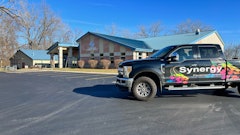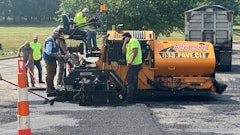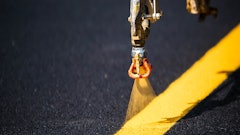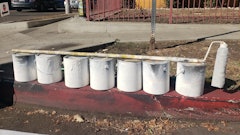Whether you're involved in sealcoating, striping, paving, or patching, your ability to accurately measure is essential to your business. From preparing bids, to tabulating paint applied, to predicting how much more mix you're going to need to finish a job, to measuring items on jobs that pay per square foot or yard, accurate and easy measurement is key to profitability.
Lucky for contractors that there are any number of companies ready to provide measuring devices to you, some with bells and whistles, some of the more basic variety, and even some at the higher-tech level.
Given the nature of the measurements you need - large areas, often with irregular shapes; lines that stop and start over a large area; or small areas of patching throughout a large area - the measuring wheel has become the measuring device of choice for most contractors. These devices are generally lightweight, often with a folding or collapsible handle, and can be relied upon to be quite accurate.
There are two types of measuring wheels: mechanical and electronic. Mechanical wheels are a little simpler to operate (though electronic wheels are not difficult) because they do less. Electronic wheels, which are battery operated, can offer more to the contractor, but of course they are priced higher.
When buying a mechanical wheel you must buy the wheel that measures in the units (feet and inches, for example) you want. If you want to switch units for some reason, you need to switch wheels. Mechanical wheels also will not store any measurements for you, so the operator needs to have pencil and paper handy to write down each measurement.
Electronic wheels, such as Calculated Industries' DigiRoller Plus II, which runs on four AA batteries, gives contractors the option of selecting from a variety of measuring units (feet-inches and yards, decimal feet-inches and yards, meters, and acres) and switching back. Electronic wheels also can store a number of measurements, making it easier to move around the parking lot without carrying a clipboard and pen to write every measurement down before moving on to the next measurement. And many electronic wheels can display and store both linear and area measurements. The DigiRoller Plus II can also calculate and store volume measurements.
One of the most obvious differences among measuring wheels is the wheel itself, which can range in size from 4 in. in diameter for Rolatape Corp.'s MM-12 Series to as much as 3 ft. in diameter for Keson Industries' Roadrunner electronic measuring wheel. Some manufacturers report wheel circumference instead of wheel size, but the larger the circumference, the larger the wheel.
So what's the deal with the wheel size? Manufacturers say that the wheel size you select should be determined by two factors: where you are going to be measuring and what kind of surface you will be measuring on. Small wheels are generally recommended for measuring indoors on concrete floors, for example, which are smooth and where areas to be measured generally are not as large as areas outdoors such as parking lots. It's also often easier to push a larger wheel along a parking lot that to walk and try to keep the small wheel (or two small wheels if it's a dual-wheel device) in constant contact with the pavement.
But the type of surface is just as important. Ernie Kaplan, KTP Enterprises, developer of the Fast-Measure device and a former paving contractor, says the larger wheels are best for rougher surfaces. "The big wheel will bridge the uneven parts of the surface and kind of level it out in the measurement. The smaller wheel will get caught on everything," Kaplan says. "But you can use small wheels on a smooth surface like a newly paved road, or even a parking lot pavement that's in good shape."
Do keep in mind that a measuring wheel is meant to be used at walking speed and may be inaccurate when rolling at speeds faster than walking or jogging.
In addition to wheel size, some wheels, such as Keson's MP415 RoadRunner, are solid and some, such as Rolatape Measuring System's 400 Series wheel, are open, with spokes like the wheel of a bicycle. The difference, again, is for where you plant to use the wheel. Solid wheels are beneficial if you're walking among grasses or weeds or anything else that might stick in the spokes, slowing or misdirecting the wheel. Solid wheels will not be affected by growth like that. But for parking lot measuring applications an open wheel is fine.
Other factors to consider include the location of the counter: Is it near the handle or near the wheel? Counters located near the ground are more difficult to read and cause greater operator fatigue because they force the operator to bend over to read the numbers.
- How large are the counter numbers? Number size affects ease of use as the smaller the numbers the more difficult they are to read.
- Is the LCD display easy to read?
- Does the wheel come with a kick stand?
- Does it have a brake so numbers it doesn't roll (and add) by accident?
- Will its counter subtract from the total when rolled backwards?
- How easily can you maneuver the wheel out the driver's window?
- How easy is the wheel to transport? Some wheels offer collapsible or telescoping handles or handles that can fold. Depending on where in your vehicle you will store your measuring wheel this could be important.
But if you're looking for the newest technology in the measuring market KTP Enterprises offers its FastMeasure Vehicle Measuring Device, which can be installed on a car, truck, or basically anything that rolls," according to Ernie Kaplan, former paving contractor and owner of KTP Enterprises.
Fast-Measure involves a display that mounts on a vehicle dashboard and sensors that install along the driveline on the vehicle. The screen displays the measurement as the vehicle travels the pavement. (And for contractors who want something with a little more zip to it, KTP offers its Fast-Measure scooter, an electric motorized scooter which has the device attached to a scooter for quick travel when measuring patches, painting out road butt joints or other longer-distance measuring. The package comes with a clip board, paint stick, seat, and battery charger, and the scooter folds up to fit into back of car.)
Fast-Measure uses a series of magnets installed on the drive shaft, wheel, axle or hub and a stainless steel sensor that mounts up to an inch away from the top of the magnets. A wire runs from the sensor to beneath the dashboard to a terminal block, where it's tied in to the dashboard-mounted display.
"Everything comes in a kit and a shop mechanic can install the first one in about an hour," Kaplan says. Calibration of the unit is straightforward. The unit features two screens - one for distance and one for speed, which can be set up in a variety of ways including miles per hour and feet per minute.
"Miles per hour doesn't tell an equipment operator much of anything," Kaplan says, "But feet per minute does. A feet-per-minute setting enables a road grinder, for example, to know when his truck is full. He sets it up so with a 2-in. grinding depth at X number of feet he knows how much of a load is in a truck, so then doesn't have to guess when the truck is full and he doesn't have to stop and check."
He adds that a distance measuring device mounted on a paver can help a paver operator monitor yield of material by tracking how many feet he has traveled since he started paving with the current truckload as well as the rate of speed the paver is traveling. A paver should only lay asphalt at approximately 150 lineal feet per minute. If a paver operator is laying mix at a speed over 175 LFP, he is smearing the asphalt on the substrate and not giving the asphalt time to tumble and roll out under the screed. Maintaining the proper speed will create a better looking mat as well as being able to achieve proper density.
Handy for sealcoating contractors bidding a job, Kaplan says Fast-Measure offers an added benefit for pavement marking contractors of being able to track how much material is put down. He says the device can be outfitted with an automatic activation switch that turns the meter on each time an operator applies paint and turns it off when paint is no longer being applied.
Tomorrow: "6 Tips to Improve Your Measuring Ease and Accuracy!"
Your Business Is Based on Your Measurements
One of the most inexpensive tools contractors need is a measuring device to help them accurately measure parking lots and driveways for estimating and bidding. These tools, available in a variety of wheel sizes with any number of bells and whistles, form the basis of your success on getting the job and performing it properly.
"Whatever type of work you're doing, whether it's cracksealing, sealcoating, paving or striping, accurate measurement forms the basis of the job," says Ernie Kaplan, president of KTP Enterprises and developer of the Fast-Measure electronic measuring device. "You already know what material you'll be using, but an accurate measurement will help you determine how much of that material you will put down. That amount forms the basis for your bid, so measurement can mean the difference between winning and losing a job."
Kaplan says measurement is not as crucial for experience contractors on small jobs such as driveways. "If you're bidding a 20 ft. x 30 ft. driveway you can make a guess at it and not be too far off. But when you start getting into parking lots, with islands, aprons, areas separated from other areas, you don't want to be guessing."
Plus, Kaplan says measuring helps determine your labor costs for the bid.
"If you know the square footage you can figure out what your labor should be to sealcoat or pave a parking lot," he says. "If your crew can sealcoating 150,000 sq. ft. in one day and the job is 600,000 sq. ft., you know you need to plan for at least four days of labor - both in your bid and in your schedule. An inaccurate measurement means less profit as the job will take longer than you bid it for."

























